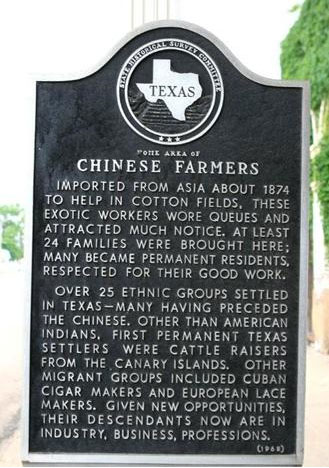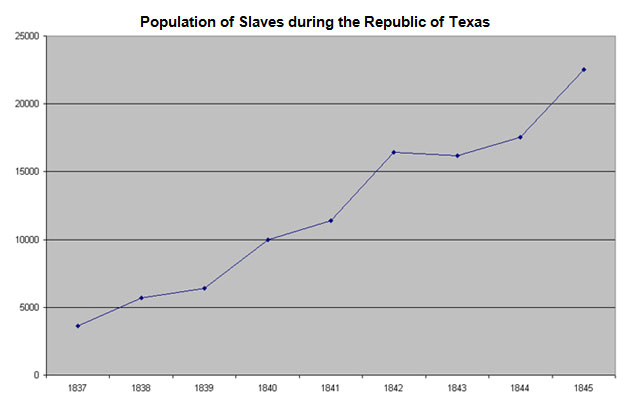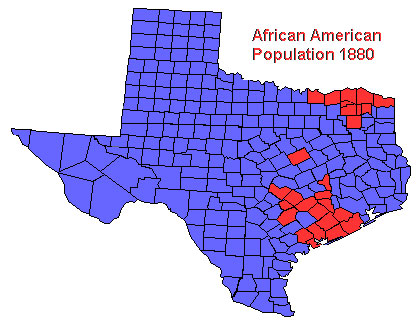
Source: Texas Calvert Chinese Farmers 5 Stephen Michaels 0508
There were many other immigrant groups that came to Texas and contributed to the Texan culture.

Source: Texas Calvert Chinese Farmers 5 Stephen Michaels 0508
Immigrants from Asia have been coming to Texas since the late 1800s. The Chinese were the first Asian group to come to Texas. They migrated from California in the 1870s under contract with railroad construction companies. After railroad construction ended most of the Chinese left the state. Those who remained in Texas lived in Robertson or El Paso counties.
After the Chinese Exclusion Act stopped the Chinese from immigrating to the United States, it was decades before more Chinese came to Texas after the act was repealed in 1943.
The historical marker, pictured here, describes the contribution of Chinese farmers and other migrant groups in Calvert, Texas.
Mexicans have played a major role in Texas throughout history. Mexicans lived in Texas while the Spanish ruled the land. After Mexico gained its independence from Spain, Mexican citizens were encouraged to migrate to Coahuila y Texas. As a result, the population of Mexican Texans increased greatly. The Mexican government needed citizens to live in the area in order to help protect its territories. When Mexico began giving land grants to help settle the area, Mexican citizens were found in almost all colonies.

Source: deleon2, Texas A&M University
Martín De Léon became the only Mexican empresario to establish a colony in Texas. Many Mexican citizens thrived in Texas colonies. De Léon’s colony was successful; he and other Mexicans became wealthy Texans.
Once Texas won its independence from Mexico in 1836, Mexicans in Texas began to face discrimination. This treatment of Mexicans slowed immigration to Texas. When Texas was annexed to the United States, some Mexicans were given citizenship while immigrants found it difficult to come to Texas until the 20th century.
Since the era of exploration in Texas, many African Americans immigrated to Texas. Esteban, the first African to come to Texas, accompanied Spanish explorer, Cabeza de Vaca across Texas in the early 1500s.
African Americans lived in Texas during the Spanish rule. During that time, African Americans could live as free men and women. When Mexico opened colonization to Anglo Americans, many of them (mainly southerners) brought slaves. Mexico’s colonization laws outlawed slavery, but the laws were not strictly enforced. Therefore, Americans continued to come to Texas with slaves.
Under the Republic of Texas, slavery was allowed and was even included in the state constitution. As a result, many slaveholders moved to Texas where they could take advantage of the availability of cheap land and slave labor. Slavery remained an institution in Texas after statehood, until 1865.
Analyze the graph below, and then answer the questions that follow in your notes.

Source: Pop of Slaves, Texas Slavery Project
Interactive popup. Assistance may be required.
The slave population increased continually with the exception of a slight dip in 1844.
Interactive popup. Assistance may be required.
According to the graph, there were about 23,000 slaves at the end of the Republic of Texas in 1845.
Interactive popup. Assistance may be required.
If the graph was extended to 1865, it would show a continued increase in the slave population of Texas. Slavery was not outlawed in Texas until 1865.
According to the Texas State Historical Association, “During the course of the Reconstruction period, many African Americans moved from the state's rural areas to cities such as Dallas, Austin, Houston, and San Antonio. On the outskirts of these cities, they established "freedmantowns," which became distinct African-American communities that still exist today.”
Look at the map below to give you an idea of where African Americans settled in Texas in the late 19th century.

Source: africanpop, LoneStar Genealogy
Click on the link below to access interactive maps on slavery in Texas.